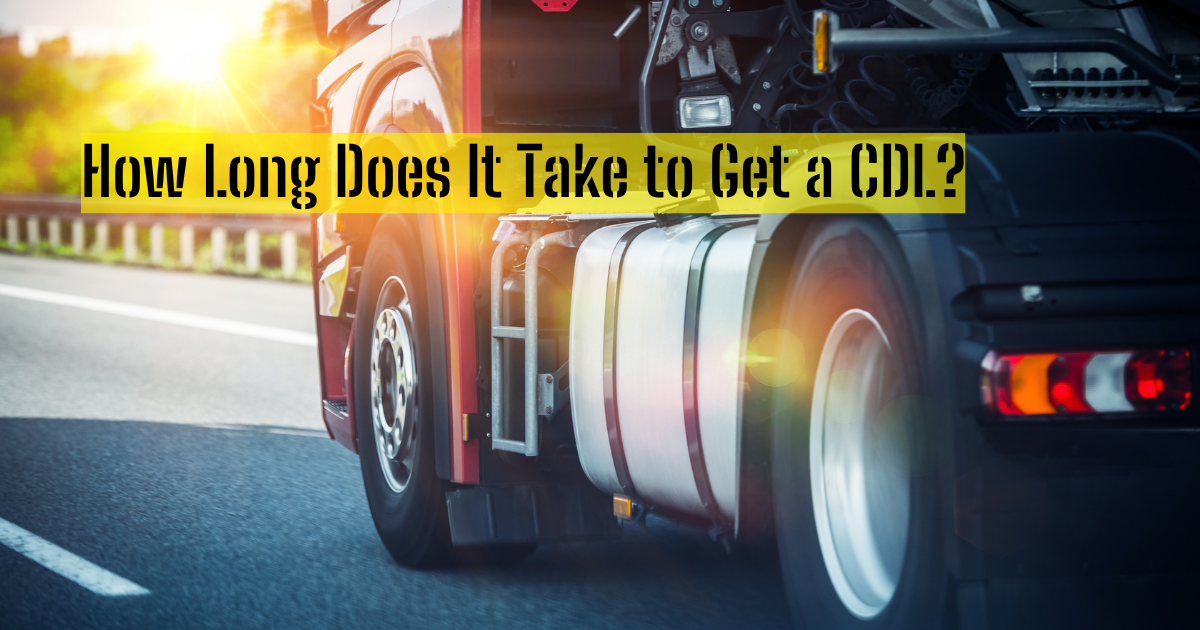A Commercial Driver’s License (CDL) is essential for anyone looking to drive large vehicles like trucks or buses professionally. Unlike a regular driver’s license, a CDL certifies that the holder is qualified to operate commercial vehicles, including tractor-trailers, tankers, and school buses. These vehicles require a higher level of skill and knowledge due to their size, weight, and unique driving dynamics.
CDLs are divided into different classes (A, B, and C), depending on the type of vehicle you want to operate. Each class has its own set of requirements and endorsements that allow drivers to carry specific types of cargo or passengers. Understanding what a CDL is and why it’s required is the first step in determining how long it will take to obtain one.
Importance of Obtaining a CDL
Obtaining a CDL opens doors to various career opportunities in the transportation industry. From long-haul truck driving to public transit, the need for qualified CDL holders is growing. A CDL not only enhances your employability but also often leads to higher wages and job stability. For those interested in the logistics and transportation sector, a CDL is more than just a license; it’s a gateway to a rewarding career.
The process of obtaining a CDL can be lengthy and requires dedication, but the rewards are significant. By understanding the steps involved, prospective drivers can better prepare for the journey ahead and set realistic expectations for how long it will take.
Overview: How Long Does It Take to Get a CDL?
The time it takes to get a CDL varies depending on several factors, including the type of CDL, the state requirements, and the individual’s schedule. On average, it can take anywhere from a few weeks to several months to complete the process. This includes the time spent on training, studying for tests, and waiting for appointments. In this guide, we’ll explore each stage of the CDL process to give you a clearer picture of what to expect.
Understanding the CDL Process
Types of CDL Licenses
CDL licenses are categorized into three classes: A, B, and C. Each class corresponds to different types of vehicles and cargo.
- Class A CDL: Allows you to operate combination vehicles with a total weight of 26,001 pounds or more, provided the towed vehicle is heavier than 10,000 pounds. This class covers tractor-trailers, tanker trucks, and flatbeds.
- Class B CDL: Permits the operation of single vehicles with a total weight of 26,001 pounds or more, or a vehicle towing a vehicle that doesn’t exceed 10,000 pounds. Examples include buses, dump trucks, and straight trucks.
- Class C CDL: For vehicles designed to transport 16 or more passengers or hazardous materials. This class includes small HAZMAT vehicles and passenger vans.
Understanding the differences between these classes is crucial, as the type of CDL you pursue will impact the time required to obtain it.
CDL Classifications: Class A, B, and C
The classification of CDL licenses is not just about the vehicle type; it also dictates the level of training and testing needed. For example, a Class A CDL requires more extensive training than a Class B or C. The type of cargo or passengers you intend to transport will determine which endorsements you need, further affecting the time and effort required to obtain your CDL.
For those aiming to drive tractor-trailers across state lines, a Class A CDL is essential. However, if your goal is to drive a school bus locally, a Class B CDL with a passenger endorsement would be more appropriate. Knowing which classification fits your career goals will help streamline the process and avoid unnecessary delays.
Factors That Affect How Long It Takes to Get a CDL
Several factors can influence the time it takes to get a CDL:
- Type of CDL and Endorsements: The more complex the license and the more endorsements you need, the longer the process.
- State Requirements: Each state has its own rules and regulations regarding CDL acquisition, including testing procedures and waiting periods.
- Training Program: Whether you choose a full-time or part-time training program will impact the time it takes to complete your training.
- Personal Schedule: Your availability to attend classes, study, and take tests will also play a significant role.
By considering these factors, you can better estimate the time required to get your CDL and plan accordingly.
Prerequisites for Getting a CDL
Minimum Age Requirements
Before you start the process of obtaining a CDL, it’s essential to meet the minimum age requirements. Generally, you must be at least 18 years old to obtain a CDL for intrastate (within the same state) driving. However, to drive commercially across state lines or transport hazardous materials, you must be 21 years old. This age requirement ensures that drivers have enough maturity and experience to handle the responsibilities of operating large commercial vehicles.
For younger drivers, starting with an intrastate CDL and gaining experience can be a good strategy. Once you turn 21, you can then expand your opportunities by obtaining the necessary endorsements for interstate or hazardous materials driving.
Educational Requirements
While there’s no specific educational requirement to obtain a CDL, most training programs recommend having at least a high school diploma or equivalent. This basic education level ensures that you have the necessary reading, writing, and math skills to understand road signs, complete logs, and perform other essential tasks. Some employers may also prefer candidates with a high school diploma, making it a valuable asset in your job search.
If you don’t have a high school diploma, consider obtaining a General Educational Development (GED) certificate before pursuing your CDL. This step can enhance your employability and make the CDL training process smoother.
Medical and Physical Qualifications
Before you can obtain a CDL, you must pass a Department of Transportation (DOT) medical exam. This exam ensures that you are physically fit to operate a commercial vehicle. The DOT exam covers various aspects of your health, including vision, hearing, blood pressure, and overall physical condition. You’ll need to pass this exam to receive a Medical Examiner’s Certificate, which is required for your CDL application.
If you have any pre-existing medical conditions, discuss them with your doctor before taking the DOT exam. Some conditions may require special considerations or waivers. Ensuring that you meet the medical and physical qualifications is a crucial step in the CDL process.
Background Checks and Driving Records
Your driving record plays a significant role in your ability to obtain a CDL. Most states require a clean driving record for a certain number of years before applying for a CDL. Traffic violations, DUIs, or accidents can delay or even prevent you from obtaining your license. Additionally, certain endorsements, such as the HAZMAT endorsement, require a thorough background check, including fingerprinting.
Before starting your CDL application, request a copy of your driving record and review it for any issues. Addressing any concerns in advance can help avoid delays in the application process.
CDL Training Programs: What to Expect
Types of CDL Training Programs
There are several types of CDL training programs available, each designed to meet different needs and schedules. These include:
- Full-Time Programs: These intensive programs are ideal for those who want to complete their training quickly. They typically last four to eight weeks and provide comprehensive instruction, including both classroom learning and hands-on driving experience.
- Part-Time Programs: If you’re balancing work or other commitments, part-time programs offer flexibility. These programs may take longer to complete, often lasting 8 to 16 weeks, but they allow you to train at your own pace.
- Company-Sponsored Programs: Some trucking companies offer training programs that cover the cost of tuition in exchange for a commitment to work for the company after obtaining your CDL. These programs can be a great option for those looking to minimize upfront costs.
Choosing the right training program depends on your schedule, learning style, and financial situation. Researching different options and considering your career goals will help you select the best fit.
How Long Does CDL Training Take?
The duration of CDL training varies depending on the type of program you choose and your schedule. Full-time programs typically take four to eight weeks, while part-time programs can extend to 16 weeks or more. The training includes both classroom instruction and behind-the-wheel practice, with a focus on safety, vehicle inspection, and road skills.
If you’re aiming for a Class A CDL, the training may take longer due to the complexity of the vehicles and the additional skills required. On the other hand, training for a Class B or C CDL may be quicker, especially if you have prior driving experience.
Understanding the time commitment involved in CDL training will help you plan your schedule and set realistic expectations for when you can complete the program and move on to the next steps.
Classroom Instruction vs. Hands-On Training
CDL training programs typically include both classroom instruction and hands-on training. Classroom instruction covers the theoretical aspects of driving, including traffic laws, safety regulations, and vehicle maintenance. This portion of the training is crucial for passing the written exams required to obtain your CDL permit.
Hands-on training, on the other hand, provides practical experience behind the wheel. You’ll learn how to operate a commercial vehicle, perform pre-trip inspections, and handle various driving scenarios. This hands-on experience is essential for passing the road test and becoming a competent driver.
Both classroom instruction and hands-on training are necessary components of the CDL process. Balancing these two aspects will help you develop the knowledge and skills needed to succeed in your new career.
Cost and Financing Options for CDL Training
The cost of CDL training can vary widely depending on the program, location, and type of CDL you’re pursuing. On average, CDL training costs range from $3,000 to $7,000. Some programs may offer additional services, such as job placement assistance or refresher courses, which can increase the overall cost.
Financing options are available for those who need assistance covering the cost of training. These include:
- Student Loans: Some schools offer financing options similar to student loans, allowing you to pay for your training over time.
- Grants and Scholarships: Various grants and scholarships are available for individuals pursuing a career in commercial driving. Researching these options can help reduce your out-of-pocket expenses.
- Company Sponsorships: As mentioned earlier, some trucking companies offer to cover the cost of training in exchange for a work commitment. This option can be particularly appealing if you’re looking to minimize upfront costs.
Understanding the cost and financing options available will help you budget for your training and avoid financial surprises.
CDL Permit: The First Step
What is a CDL Permit?
Before you can obtain a full CDL, you must first acquire a Commercial Learner’s Permit (CLP). The CLP allows you to practice driving a commercial vehicle under the supervision of a licensed CDL holder. This permit is a crucial step in the CDL process, as it provides the hands-on experience needed to pass the road test.
To obtain a CLP, you must pass a written knowledge test that covers topics such as traffic laws, vehicle operation, and safety regulations. The CLP is typically valid for six months, giving you ample time to practice and prepare for the road test.
Understanding the role of the CLP in the CDL process will help you approach your training with confidence and focus on the skills needed to succeed.
How to Prepare for the CDL Permit Test
Preparing for the CDL permit test requires a solid understanding of the material covered in the exam. Most states provide a CDL handbook that outlines the topics you’ll need to study, including general knowledge, air brakes, and specific endorsements. Studying this handbook thoroughly is essential for passing the written test.
In addition to self-study, many CDL training programs offer classroom instruction that covers the material on the permit test. This structured learning environment can be particularly beneficial for those who prefer guided instruction.
Taking practice tests is another effective way to prepare. These tests simulate the format and content of the actual exam, allowing you to gauge your readiness and identify areas where you may need additional study.
How Long Does It Take to Get a CDL Permit?
The time it takes to obtain a CDL permit depends on how quickly you can prepare for and pass the written knowledge test. For some, this may take just a few days, while others may need several weeks of study. Once you pass the test, the permit is usually issued on the same day.
After obtaining your CLP, you’ll need to hold it for a minimum period, usually 14 days, before you’re eligible to take the road test. This waiting period allows you to gain practical driving experience under supervision, which is essential for passing the road test and obtaining your full CDL.
Time Limits and Restrictions on CDL Permits
While the CDL permit is a vital step in the process, it comes with certain time limits and restrictions. The permit is typically valid for six months, during which time you must complete your training and pass the road test. If you fail to do so within this period, you may need to renew your permit or retake the written test.
In addition to time limits, the CDL permit restricts you from driving a commercial vehicle without a licensed CDL holder in the passenger seat. These restrictions are designed to ensure that you gain experience under supervision and are fully prepared for the responsibilities of driving a commercial vehicle on your own.
The Road Test: Key to Getting Your CDL
What to Expect During the CDL Road Test
The CDL road test is the final hurdle in obtaining your commercial driver’s license. This test is designed to assess your ability to operate a commercial vehicle safely and effectively. The road test typically consists of three parts: a pre-trip inspection, a basic control skills test, and an on-road driving test.
- Pre-Trip Inspection: You’ll be required to inspect your vehicle and explain the process to the examiner. This part of the test assesses your knowledge of vehicle safety and maintenance.
- Basic Control Skills Test: This section evaluates your ability to maneuver the vehicle in various situations, such as backing up, making tight turns, and parking.
- On-Road Driving Test: The final part of the test involves driving the vehicle on public roads, where you’ll be assessed on your ability to follow traffic laws, manage different driving conditions, and operate the vehicle safely.
Knowing what to expect during the road test will help you prepare effectively and increase your chances of passing on the first attempt.
How Long Does It Take to Schedule and Pass the CDL Road Test?
Scheduling the CDL road test can vary depending on the state and the availability of testing centers. In some areas, you may be able to schedule the test within a few days, while in others, you might have to wait several weeks. It’s advisable to schedule your test as soon as you feel confident in your skills to avoid unnecessary delays.
The road test itself typically takes about two to three hours to complete. If you pass, you’ll receive your CDL either on the same day or within a few days, depending on your state’s processing time.
The time it takes to pass the road test depends on your level of preparation and experience. Proper training and practice are key to passing the test on your first try, which will save you time and reduce the overall duration of the CDL process.
Common Mistakes to Avoid During the Road Test
The CDL road test can be challenging, but understanding common mistakes can help you avoid them and increase your chances of success. Some of the most frequent errors include:
- Incomplete Pre-Trip Inspection: Failing to thoroughly check all components of the vehicle or forgetting to explain the inspection process to the examiner.
- Poor Vehicle Control: Struggling with basic maneuvers, such as backing up or making sharp turns, can result in point deductions or even failure.
- Failure to Follow Traffic Laws: Not obeying speed limits, traffic signals, or other road signs during the on-road portion of the test.
- Nervousness and Hesitation: Overthinking or second-guessing yourself can lead to mistakes. Confidence in your abilities is crucial.
By being aware of these common mistakes and practicing diligently, you can approach the road test with confidence and increase your chances of passing on the first attempt.
Re-Taking the CDL Road Test: What You Need to Know
If you don’t pass the CDL road test on your first attempt, don’t be discouraged. Many drivers need more than one try to succeed. Most states allow you to retake the test after a short waiting period, typically a few days to a week. However, you may need to pay a retest fee, so it’s essential to prepare thoroughly before your next attempt.
Use the time between tests to practice the areas where you struggled and review any feedback provided by the examiner. With additional preparation, you’ll be better equipped to pass the test on your next try.
How Long Does It Take to Get a CDL in Different States?
State-by-State CDL Processing Times
The time it takes to get a CDL can vary significantly depending on the state where you apply. Some states have more streamlined processes, while others may have longer waiting periods due to higher demand or more stringent requirements. It’s important to research the specific requirements and processing times in your state to set realistic expectations.
In states with high demand for CDL testing, you may encounter longer wait times for both the written and road tests. Planning ahead and scheduling your tests as early as possible can help you avoid delays.
The Impact of State-Specific Requirements
In addition to varying processing times, states may have different requirements for obtaining a CDL. These can include additional tests, specific endorsements, or unique training requirements. Understanding the requirements in your state will help you navigate the process more efficiently.
For example, some states require additional training or testing for certain endorsements, such as HAZMAT or passenger transport. These requirements can add time to the CDL process, so it’s essential to factor them into your timeline.
How to Expedite the CDL Process in Your State
If you’re looking to obtain your CDL as quickly as possible, there are a few strategies you can use to expedite the process:
- Research State Requirements: Understanding the specific requirements in your state will help you avoid delays and ensure you meet all necessary criteria.
- Schedule Tests Early: Test appointments can fill up quickly, so it’s essential to schedule your written and road tests as soon as you’re ready.
- Consider a Training Program: Enrolling in a CDL training program can help you complete the necessary training more quickly and efficiently.
- Prepare Thoroughly: The better prepared you are for the tests, the less likely you are to need retakes, which can save time.
By taking these steps, you can streamline the CDL process and obtain your license in the shortest time possible.
CDL Endorsements: Extending Your License
Types of CDL Endorsements
CDL endorsements are additional qualifications that allow you to operate specific types of vehicles or carry particular types of cargo. Some of the most common endorsements include:
- Tanker (N): Required to operate vehicles that transport liquids in bulk.
- Hazardous Materials (H): Necessary for drivers transporting hazardous materials, such as chemicals or explosives.
- Passenger (P): Required for drivers transporting 16 or more passengers, such as school bus drivers.
- Double/Triple Trailers (T): Needed for operating vehicles with double or triple trailers.
- School Bus (S): Specifically for drivers operating school buses.
Each endorsement requires additional testing and may involve both written and road tests. Understanding the types of endorsements available will help you determine which ones you need for your desired career path.
How Long Does It Take to Get a CDL Endorsement?
The time it takes to obtain a CDL endorsement depends on the type of endorsement and the testing requirements. Some endorsements, such as the Tanker or Passenger endorsement, may only require a written test, while others, like the HAZMAT endorsement, may involve a background check and additional training.
In general, obtaining a CDL endorsement can add a few days to several weeks to the overall CDL process. It’s important to plan for this additional time if you require specific endorsements for your job.
The Benefits of Having Multiple CDL Endorsements
Having multiple CDL endorsements can significantly enhance your career prospects in the trucking industry. Endorsements demonstrate your ability to handle specialized vehicles and cargo, making you more attractive to potential employers. Additionally, endorsements can lead to higher-paying job opportunities and greater job security.
For example, drivers with a HAZMAT endorsement often earn more than those without it, due to the additional risks and responsibilities involved in transporting hazardous materials. Similarly, having a Passenger endorsement can open up opportunities in the bus transportation industry.
By investing the time to obtain multiple endorsements, you can increase your earning potential and expand your career options.
Maintaining and Renewing Your CDL
How Long is a CDL Valid?
Once you obtain your CDL, it’s important to understand how long it remains valid and the steps required to maintain it. In most states, a CDL is valid for five to eight years, depending on the state’s regulations. However, certain endorsements, such as the HAZMAT endorsement, may require more frequent renewal due to additional security requirements.
It’s essential to keep track of your CDL’s expiration date and begin the renewal process well in advance to avoid any lapses in your licensure.
The CDL Renewal Process
Renewing your CDL involves several steps, including a vision test, a medical examination, and a review of your driving record. Some states may also require a written or road test, depending on how long it’s been since you last renewed your license.
The renewal process typically begins several months before your CDL’s expiration date. You’ll need to provide updated medical documentation, proof of identity, and payment for the renewal fee. Once your renewal is processed, your new CDL will be issued, usually with an updated expiration date.
Maintaining a Clean Driving Record
Maintaining a clean driving record is crucial for keeping your CDL in good standing. Traffic violations, accidents, and other infractions can lead to points on your record, which may result in fines, penalties, or even the suspension of your CDL. Additionally, certain violations, such as driving under the influence, can result in the permanent revocation of your license.
To protect your CDL and your career, it’s important to adhere to all traffic laws, practice safe driving habits, and avoid risky behavior on the road. Employers often review your driving record as part of the hiring process, so a clean record can also improve your job prospects.
Conclusion
Obtaining a CDL is a process that requires careful planning, preparation, and dedication. From meeting the basic eligibility requirements to passing the road test, each step is essential for achieving your goal of becoming a licensed commercial driver. By understanding the time and effort involved, you can approach the CDL process with confidence and work towards a successful career in the trucking industry. Whether you’re pursuing a specific endorsement or looking to expedite the process in your state, the information provided in this guide will help you navigate the journey to obtaining your CDL and starting your new career on the right foot.









